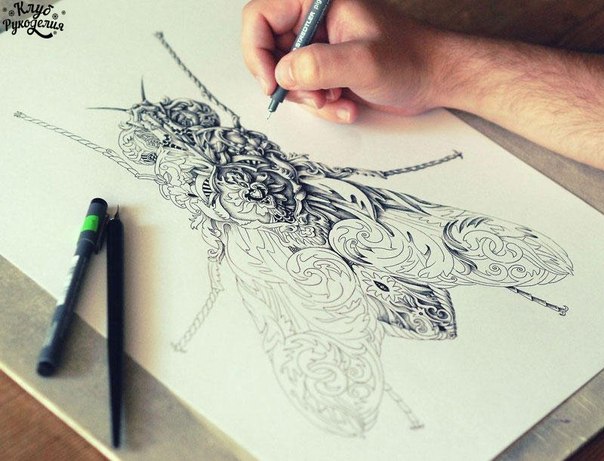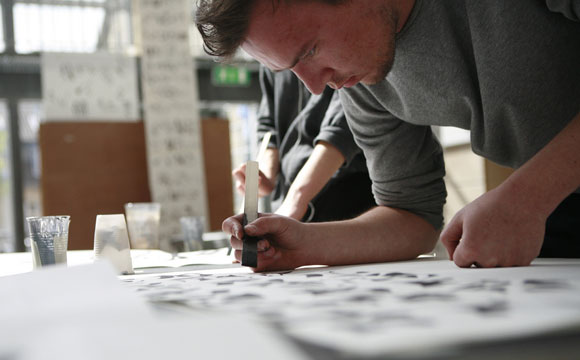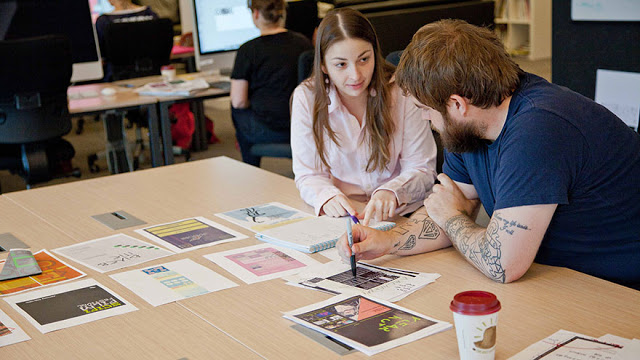Specialized Hands-On Design Careers
Specialized designers work in a specific area of the print graphic design field—either a particular medium or a particular category of designs.
Commercial Artist/Illustrator
Job Description: A commercial artist or illustrator is someone who creates illustrations and other graphics for a wide range of print publications. This can include everything from illustrating print advertisements, creating branding materials and mascots, cartooning, illustrating books and more. The basic difference between a commercial illustrator and a fine artist is that a commercial illustrator creates work for a client. Typically, a commercial illustrator works freelance or is employed by a marketing firm or advertising agency.

Why You Need to Know Print: Whether an artist works with traditional materials or digitally, they must still create illustrations that look good in print. That means working with Pantone colors or CMYK-friendly tones, depending on the type of print job it will be. Knowing the tenets of good design is important for any illustrator or artist, whether they work commercially or not.
Education/Experience: As a commercial illustrator, you will be considered for employment by the strength of your portfolio, not necessarily your educational background. That being said, some sort of formal training is advised in order to strengthen your abilities and improve your skill.
Estimated Salary: $39,500 to $75,500 annually
Pros:
- A good way for artists to support themselves while working on their own creative works
- Ability to work freelance and pick your own clients
- Every field uses commercial illustration in one way or another, so there are plenty of opportunities to draw what you feel comfortable with
Cons:
- Can be a highly stressful occupation having to find new clients, juggle deadlines and overcome creative hurdles
- Requires you to constantly improve your craft, which means working and practicing even when you’re not being paid for it
Logo Designer
Job Description: Logo design is such a specialized skill that the designers who are best at it can often make a living doing nothing but designing logos. Logos make up such a crucial aspect of a brand’s identity that these tend to be high-paying jobs with a high level of stress. A logo designer’s work will inform all the design work that comes after it, since the logo will be featured in all of the brand’s web and print designs.

Why You Need to Know Print: A logo designer has to be aware of how his or her work is going to be used in the future-that includes any printed materials the brand may create. Not only do logos have to look good in print, they have to look good when printed in only one ink color. Logo designers have to prepare for all print possibilities, and the best way to do that is to have some experience with print design. Education/Experience: Since this is such a specialized area of design, you need a specialized background to be able to make it. A degree in design is important, but you’ll also need experience with marketing, either on the job or in the classroom-preferably a mix of the two. Of course, to be able to make it as a logo designer, you’ll need a pretty impressive portfolio with a focus on your past successes in logo design.
Estimated Salary: $52,670 annually
Pros:
- A good logo designer can fetch a lot of money for a logo, since it’ll be used so much in a brand’s marketing
- Can go into business for yourself or work alongside marketing and advertising agencies
- There’s always new work as new brands start up and established brands look to rebrand themselves
Cons:
- Difficult to get into the field, you really have to know your stuff and have experience in the past creating successful logos for brands
- Can be a highly stressful profession with a lot of creative requirements
- You may have to work on spec or compete with other designers for the work
Packaging Designer
Job Description: Most of the stuff you buy at the store comes in some sort of packaging. It is a designer’s job to create the look and functionality of the packaging itself to present the product in the best possible way. They say to never judge a book by its cover, but sometimes we just can’t help it-so it’s a packaging designer’s job to make sure that cover looks as good as the contents inside. Packaging design requires more than just making a design that goes onto the packaging, it’s also about figuring out the shape and size of the packaging itself. How will the customer perceive it, and how will they use it? How will it fit on a shelf at the store or be shipped out to storefronts to be sold? These are the questions the packaging designer has to think about.

Why You Need to Know Print: The best packaging designers have a background in print. A packaging designer, like a print graphic designer, has to worry about the feel of the end product as much as the look. There are also similar restrictions on your design. You may be limited to a certain number of ink colors or other particular specifications.
Experience/Education: Most jobs in this field will require at least a bachelor’s degree in a related field such as design or marketing. There are entry-level positions available, but some may also require you to work an unpaid internship or go through on-site training. Having experience with art and design is a must, but some packaging designers come into the field from an industrial or engineering background.
Estimated Salary: $57,750 to $86,500 annually
Pros:
- Can be a well-paying job with lots of room to grow for the right individual
- Plenty of creative freedom in a work environment where innovation is highly regarded
Cons:
- Depending on your level of responsibilities, you can run into a lot of stress on the job
- Working in a specialized field can make it harder for you to find work
Print Marketing Designer
Job Description: If you’re creating a print design for a client, chances are there is some level of marketing involved. However, those who choose to work solely in print marketing often do so as a part of a marketing firm or advertising agency. Print marketing jobs can range from entry-level to senior level and beyond, and typically require you work either as part of the team or as head of it. Rarely will a print marketing specialist work in a complete vacuum, other than those working in freelance (and even then, you can expect a high level of input from your clients and their marketing teams). Print marketing designers focus solely on creating print marketing campaigns for their clients. Typically, this covers all aspects of print design, including business cards, letterheads, presentation folders, postcards, mailers, flyer, coupons, brochures and booklets. However, it is possible to present yourself as an expert in just one specialized print discipline, such as being the best presentation folder designer available.

Why You Need to Know Print: You can’t get a job as a print marketing designer without some knowledge of how print design works and how to overcome any limitations that print may present. Since print marketing is all about selling a brand’s identity, you won’t have time to learn how to use a print template or work with PMS colors while on the job—you’ll be expected to already know that. Instead you’ll be focused on how to best bring a brand’s identity to the audience’s attention.
Experience/Education: For the most part, an entry level position is going to require you to have a degree in either design or marketing, with professional work experience making up the difference in either category. It’s not enough to just be able to make a design look good; you have to know how to be able to sell a brand and how to get customers excited about a product or service. Depending on your level or role within the organization, this may be entirely on your shoulders, or you may work directly under a creative/art director.
Estimated Salary: Varies greatly depending on experience level
Pros:
- Plenty of job opportunities, as most design jobs require knowledge of marketing practices
- Lots of room to grow with a wide range of jobs available, from internships and entry level jobs to senior level positions or creative directors
Cons:
- Many marketing firms may want you to have experience with web design as well, in order to facilitate a full marketing campaign without seeking additional outside design help
- Can lead to a high-stress work environment depending on your responsibilities, especially when servicing particularly finicky clients
Print Publication Designer
Job Description: Print publication designers are the people responsible for putting together print media such as newspapers, magazines, books and graphic novels. Designers that work in print publication have to be good at laying out pages and making sure all of the content is readable and arranged in a sensible way. The kinds of tasks you will be doing will vary depending on the type of publication you work for. As a print publication designer, you could be tasked with anything from creating magazine ads, laying out newspaper articles, designing book covers and more.

Why You Need to Know Print: The process for printing a publication is not much different than any other print job, so learning the basics of print will be useful in this field. Depending on the type of publication you’d like to work for, you may need specialized print training. For example, if you want to design for books, you’ll need an understand of how book printing and binding works.
Experience/Education: A four year degree in design is recommended, but you’ll also need to have some knowledge of journalism, writing, typographical design and other specialized fields related to the publication you’d like to work for. Three to four years of experience in the field is also recommended, although you might be able to find a few entry level positions or internships.
Estimated Salary: $44,320 annually
Pros: A more prestigious job that allows your work to be seen by a much wider audience Can work directly for a publisher or work freelance for several publishers
Cons:
- Publication deadlines lead to a higher stress work environment
- Can be hard to find work in this competitive field, as print publication is dwindling
- May need to relocate to a bigger city to find work
Source: companyfolders.com